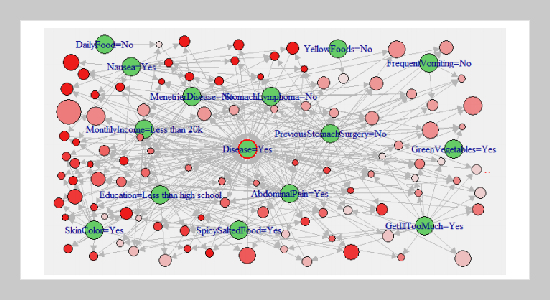Md. Rejaul Islam Royel1 , Md. Ajmanur Jaman1 , Fuyad Al Masud1,2 , Arzo Ahmed3 , Abdul Muyeed4 , and Kawsar Ahmed This email address is being protected from spambots. You need JavaScript enabled to view it.2,5
1Department of Software Engineering (SWE), Daffodil International University, Dhaka, Bangladesh
2Department of Information and Communication Technology (ICT), Mawlana Bhashani Science and Technology University, Tangail-1902, Bangladesh
3Department of Statistics, Mawlana Bhashani Science and Technology University, Tangail-1902, Bangladesh
4Department of Statistics, Jatiya Kabi Kazi Nazrul Islam University, Trishal, Bangladesh
5Group of Bio-photomatix, Department of Information and Communication Technology (ICT), Mawlana Bhashani Science and Technology University, Tangail-1902, Bangladesh
REFERENCES
- [1] Guoqin Yu, Nan Hu, Lemin Wang, Chaoyu Wang, Xiao You Han, Mike Humphry, Jacques Ravel, Christian C. Abnet, Philip R. Taylor, and Alisa M. Goldstein. Gastric microbiota features associated with cancer risk factors and clinical outcomes: A pilot study in gastric cardia cancer patients from Shanxi, China. International Journal of Cancer, 141(1):45–51, jul 2017.
- [2] D. Pottier. Cancer Incidence in Five Continents. Population-at-risk. IARC scientific publications, (120):174–177, 1992.
- [3] M Kurihara, K Aoki, and S Hisamichi. Cancer Mortality Statistics in the World: 1950-1985. 1989.
- [4] Timothy L Cover. Helicobacter pylori diversity and gastric cancer risk, 2016.
- [5] Syed Akram Hussain and Richard Sullivan. Cancer control in Bangladesh, 2013.
- [6] Lis Ellison-Loschmann, Andrew Sporle, Marine Corbin, Soo Cheng, Pauline Harawira, Michelle Gray, Tracey Whaanga, Parry Guilford, Jonathan Koea, and Neil Pearce. Risk of stomach cancer in Aotearoa/New Zealand: A Maori population based case-control study. ¯ PLoS ONE, 12(7), jul 2017.
- [7] Susan Greenhalgh. Diet, Life-style and Mortality in China: A Study of the Characteristics of 65 Chinese Counties. Population Studies, 46(1):177–178, 1992.
- [8] Leonard Marquart. Whole Grain Intake and Cancer: A Review of the Literature, jan 1995.
- [9] Massimo Rugge, Matteo Fassan, and David Y. Graham. Epidemiology of gastric cancer. In Gastric Cancer: Principles and Practice, pages 23–34. 2015.
- [10] Naohito Yamaguchi and Tadao Kakizoe. Synergistic interaction between Helicobacter pylori gastritis and diet in gastric cancer, 2001.
- [11] Christopher P Howson, Tomohiko Hiyama, and Ernst L Wynder. The decline in gastric cancer: Epidemiology of an unplanned triumph. Epidemiologic Reviews, 8(1):1–27, 1986.
- [12] David Schottenfeld and Joseph F. Fraumeni. Cancer Epidemiology and Prevention, volume 9780195149. 2009.
- [13] Paul Terry, Olof Nyrén, and Jonathan Yuen. Protective effect of fruits and vegetables on stomach cancer in a cohort of Swedish twins. International Journal of Cancer, 76(1):35–37, 1998.
- [14] World Cancer Research Fund and American Institute for Cancer Research. Food, Nutrition and the Prevention of Cancer: A Global Perspective. In Washington DC: American Institute for Cancer Research, 1997.
- [15] World Cancer Research Fund. Diet, nutrition and the prevention of cancer: a global perspective. In World Cancer Research Fund, Washington, USA, 1997.
- [16] Asha Gowda Karegowda, A S Manjunath, and M A Jayaram. Comparative Study of Attribute Selection Using Gain Ratio and Correlation Based Feature Selection. International Journal of Information Technology and Knowledge Management, 2(2):271–277, 2010.
- [17] Bangsuk Jantawan and Cheng-fa Tsai. A Comparison of Filter and Wrapper Approaches with Data Mining Techniques for. International Journal of Innovative Research in Computer and Communication Engineering, 2(6):4501–4508, 2014.
- [18] RJ Urbanowicz, M Meeker, W La Cava, RS Olson, and JH Moore. Relief-based feature selection: Introduction and review. Journal of biomedical informatics, 2018.
- [19] Nicole Dalia Cilia, Claudio De Stefano, Francesco Fontanella, and Alessandra Scotto di Freca. A rankingbased feature selection approach for handwritten character recognition. Pattern Recognition Letters, 121:77–86, 2019.
- [20] Joseph A. Cruz and David S. Wishart. Applications of machine learning in cancer prediction and prognosis, 2006.
- [21] Illhoi Yoo, Patricia Alafaireet, Miroslav Marinov, Keila Pena-Hernandez, Rajitha Gopidi, Jia Fu Chang, and Lei Hua. Data mining in healthcare and biomedicine: A survey of the literature. Journal of Medical Systems, 36(4):2431–2448, aug 2012.
- [22] Seyed Abbas Mahmoodi, Kamal Mirzaie, and Seyed Mostafa Mahmoudi. A new algorithm to extract hidden rules of gastric cancer data based on ontology. SpringerPlus, 5(1), dec 2016.
- [23] Michael Hahsler and Sudheer Chelluboina. Visualizing Association Rules: Introduction to the R-extension Package arulesViz. R project module, pages 1–24, 2011.
- [24] Kawsar Ahmed, Md. Ahsan Habib, Tasnuba Jesmin, Md. Zamilur Rahman, and Md. Badrul Alam Miah. Prediction of Breast Cancer Risk Level with Risk Factors in Perspective to Bangladeshi Women using Data Mining. International Journal of Computer Applications, 82(4):36–41, 2013.
- [25] Tasnuba Jesmin, Kawsar Ahmed, Md. Zamilur Rahman, and Md. Badrul Alam Miah. Brain Cancer Risk Prediction Tool using Data Mining. International Journal of Computer Applications, 61(12):22–27, 2013.
- [26] Kawsar Ahmed, Abdullah Al-Emran, Tasnuba Jesmin, Roushney Fatima Mukti, Md Zamilur Rahman, and Farzana Ahmed. Early detection of lung cancer risk using data mining. Asian Pacific Journal of Cancer Prevention, 14(1):595–598, 2013.
- [27] Hye Min Jung, Jin Seok Lee, David R. Lairson, and Yoon Kim. The effect of national cancer screening on disparity reduction in cancer stage at diagnosis by income level. PLoS ONE, 10(8), aug 2015.
- [28] Paule Latino-Martel, Vanessa Cottet, Nathalie Druesne-Pecollo, Fabrice H.F. Pierre, Marina Touillaud, Mathilde Touvier, Marie Paule Vasson, Mélanie Deschasaux, Julie Le Merdy, Emilie Barrandon, and Raphaëlle Ancellin. Alcoholic beverages, obesity, physical activity and other nutritional factors, and cancer risk: A review of the evidence, 2016.
- [29] Monica S. Sierra, Patricia Cueva, Luis Eduardo Bravo, and David Forman. Stomach cancer burden in Central and South America. Cancer Epidemiology, 44:S62–S73, 2016.
- [30] Chikara Kunisaki, Hiroaki Miyata, Hiroyuki Konno, Zenichiro Saze, Norimichi Hirahara, Hirotoshi Kikuchi, Go Wakabayashi, Mitsukazu Gotoh, and Masaki Mori. Modeling preoperative risk factors for potentially lethal morbidities using a nationwide Japanese web-based database of patients undergoing distal gastrectomy for gastric cancer. Gastric Cancer, 20(3):496–507, 2017.
















